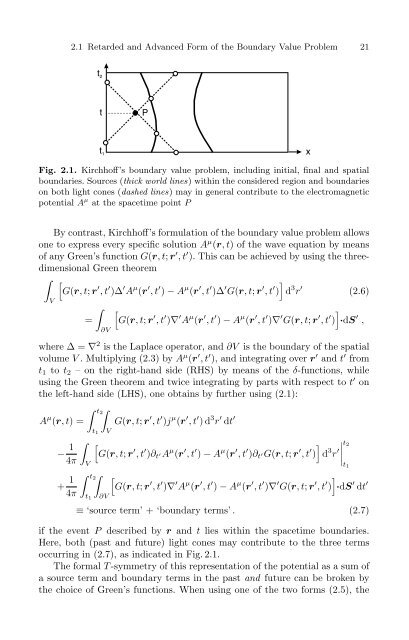The Physical Basis of The Direction of Time (The Frontiers ...
The Physical Basis of The Direction of Time (The Frontiers ...
The Physical Basis of The Direction of Time (The Frontiers ...
Create successful ePaper yourself
Turn your PDF publications into a flip-book with our unique Google optimized e-Paper software.
2.1 Retarded and Advanced Form <strong>of</strong> the Boundary Value Problem 21<br />
t 2<br />
t<br />
P<br />
t 1<br />
x<br />
Fig. 2.1. Kirchh<strong>of</strong>f’s boundary value problem, including initial, final and spatial<br />
boundaries. Sources (thick world lines) within the considered region and boundaries<br />
on both light cones (dashed lines) may in general contribute to the electromagnetic<br />
potential A µ at the spacetime point P<br />
By contrast, Kirchh<strong>of</strong>f’s formulation <strong>of</strong> the boundary value problem allows<br />
one to express every specific solution A µ (r,t) <strong>of</strong> the wave equation by means<br />
<strong>of</strong> any Green’s function G(r,t; r ′ ,t ′ ). This can be achieved by using the threedimensional<br />
Green theorem<br />
∫ [<br />
]<br />
G(r,t; r ′ ,t ′ )∆ ′ A µ (r ′ ,t ′ ) − A µ (r ′ ,t ′ )∆ ′ G(r,t; r ′ ,t ′ ) d 3 r ′ (2.6)<br />
V<br />
∫<br />
=<br />
∂V<br />
[<br />
]<br />
G(r,t; r ′ ,t ′ )∇ ′ A µ (r ′ ,t ′ ) − A µ (r ′ ,t ′ )∇ ′ G(r,t; r ′ ,t ′ ) ·dS ′ ,<br />
where ∆ = ∇ 2 is the Laplace operator, and ∂V is the boundary <strong>of</strong> the spatial<br />
volume V . Multiplying (2.3) by A µ (r ′ ,t ′ ), and integrating over r ′ and t ′ from<br />
t 1 to t 2 – on the right-hand side (RHS) by means <strong>of</strong> the δ-functions, while<br />
using the Green theorem and twice integrating by parts with respect to t ′ on<br />
the left-hand side (LHS), one obtains by further using (2.1):<br />
A µ (r,t)=<br />
− 1 ∫<br />
4π V<br />
+ 1<br />
4π<br />
∫ t2<br />
∫ t2<br />
t 1<br />
∫V<br />
G(r,t; r ′ ,t ′ )j µ (r ′ ,t ′ )d 3 r ′ dt ′<br />
[<br />
G(r,t; r ′ ,t ′ )∂ t ′A µ (r ′ ,t ′ ) − A µ (r ′ ,t ′ )∂ t ′G(r,t; r ′ ,t ′ )<br />
t 1<br />
∫∂V<br />
]<br />
d 3 r ′ ∣ ∣∣∣<br />
t 2<br />
[<br />
]<br />
G(r,t; r ′ ,t ′ )∇ ′ A µ (r ′ ,t ′ ) − A µ (r ′ ,t ′ )∇ ′ G(r,t; r ′ ,t ′ ) ·dS ′ dt ′<br />
≡ ‘source term’ + ‘boundary terms’ . (2.7)<br />
if the event P described by r and t lies within the spacetime boundaries.<br />
Here, both (past and future) light cones may contribute to the three terms<br />
occurring in (2.7), as indicated in Fig. 2.1.<br />
<strong>The</strong> formal T -symmetry <strong>of</strong> this representation <strong>of</strong> the potential as a sum <strong>of</strong><br />
a source term and boundary terms in the past and future can be broken by<br />
the choice <strong>of</strong> Green’s functions. When using one <strong>of</strong> the two forms (2.5), the<br />
t 1



![arXiv:1001.0993v1 [hep-ph] 6 Jan 2010](https://img.yumpu.com/51282177/1/190x245/arxiv10010993v1-hep-ph-6-jan-2010.jpg?quality=85)


![arXiv:1008.3907v2 [astro-ph.CO] 1 Nov 2011](https://img.yumpu.com/48909562/1/190x245/arxiv10083907v2-astro-phco-1-nov-2011.jpg?quality=85)








![arXiv:1002.4928v1 [gr-qc] 26 Feb 2010](https://img.yumpu.com/41209516/1/190x245/arxiv10024928v1-gr-qc-26-feb-2010.jpg?quality=85)
![arXiv:1206.2653v1 [astro-ph.CO] 12 Jun 2012](https://img.yumpu.com/39510078/1/190x245/arxiv12062653v1-astro-phco-12-jun-2012.jpg?quality=85)
